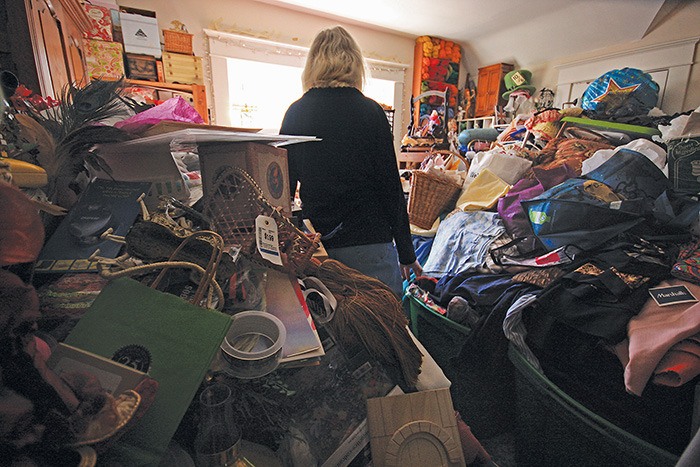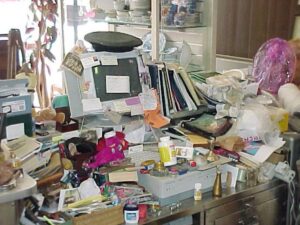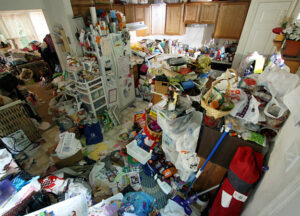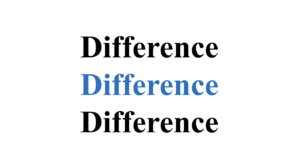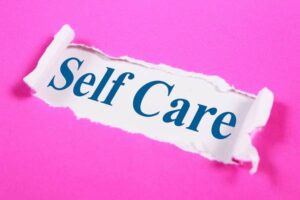Clutter and hoarding are often confused with one another, but there is a big difference between the two. Clutter is simply an accumulation of things that you do not need and have no use for. Hoarding, on the other hand, is when someone accumulates so much stuff that it becomes difficult to use their living space effectively. In this blog post, we will discuss the differences between clutter and hoarding, as well as provide tips on how to get rid of clutter in your home.
Contents
What Is Clutter? 
Clutter is a collection of things that are usually considered to be junk or unnecessary, and it often builds up in homes over time. This can be anything from old clothes to magazines and books.
Clutter is simply having too much stuff and not enough space to put it all. It happens to everyone at some point or another. Maybe you’ve held onto clothes that are too small or kept every holiday decoration you’ve ever bought.
What Is Hoarding? 
Hoarding is when a person can’t let go of things because they believe they will need them in the future. Even if the items are broken, useless, or take up too much space, they can’t bear to get rid of them.
For hoarders, letting go feels like giving up a part of themselves. Hoarding makes it difficult for people to use their living spaces the way they’re supposed to be used. For example, a hoarder’s bedroom might be so full of stuff that there’s only enough room to sleep in the bed.
What Are The Differences?
One key difference between clutter and hoarding is that clutter does not typically interfere with daily activities or functioning, whereas hoarding can make it difficult to cook, clean, or even move around in one’s own home.
Another difference is that people who hoard often acquire things that are of little value or use (e.g., old newspapers), whereas people with clutter tend to hold onto things that are cluttered often more easily recognizable and manageable than hoarding.
Here are some examples to help explain the difference:
- Clutter: Your home is full of clothes, shoes, books, and knick-knacks that you’ve amassed over the years. It’s cluttered because there’s just too much stuff and it’s not sorted or arranged in any particular way. But you still use all of these things regularly.
- Hoarding: You have so much stuff crammed into your home that you can barely move around. And a lot of the things you’re keeping are things that you don’t need or use, like old newspapers or clothes that no longer fit. But you can’t bear to get rid of them because “you might need them someday.”
Another key difference between clutter and hoarding is that people who hoard generally attach sentimental value to their belongings, even if others see them as junk. For example, a person might hoard old newspapers because they contain articles about a loved one or a historic event. Someone with clutter might have a pile of old newspapers, but they’re not as attached to them and would be more likely to throw them away.
Another difference is that clutter is usually found throughout the home, while hoarding tends to be concentrated in one area. A person with clutter might have a messy bedroom or a cluttered kitchen counter, but their whole house isn’t necessarily crammed with stuff. Some hoarders often have one or two “safe” rooms where they keep their things and the rest of the house may be relatively clean.
Finally, people with clutter are generally aware that their belongings are causing problems and are often embarrassed by the mess. They may try to hide it from others or feel ashamed of their living conditions. People who hoard, on the other hand, may not see their behavior as a problem and often don’t want to part with their things, even if it causes hardship for them or their loved ones.
What Are The Similarities?
Clutter and hoarding can both be related to an individual’s emotional state. For example, someone who is going through a divorce may hoard items as a way to hold onto memories of their former spouse. Or, someone who is grieving the death of a loved one may clutter their home with mementos and keepsakes. In both cases, the person is using material possessions to deal with difficult emotions.
Another similarity between clutter and hoarding is that both can cause problems in day-to-day life. Clutter can make it difficult to find things you need, and it can also be dangerous if it blocks exits or creates trip hazards. Hoarding can also make daily life difficult since it often leads to cluttered and unsafe living conditions.
Finally, both clutter and hoarding can be frustrating for family and friends who care about the person affected. Seeing a loved one struggle with disorganization or an inability to let go of things can be difficult, especially if it’s impacting their quality of life.
What Are The Risk Factors?
Many risk elements cause clutter and hoarding. These include:
Having a lot of stuff
This is one of the most common risk factors for clutter and hoarding. When you have too much stuff, it can be difficult to keep track of everything and keep your living space organized. It may result in clutter or hoarding. For example, if you have a lot of clothes, you may end up with a cluttered closet or dresser. If you have too many books, you may have difficulty finding a place to put them all and may start to hoard them.
Having a messy living space
When your living space is messy, it can be difficult to find things and keep track of your belongings. This may result in clutter or hoarding. For example, if you have a cluttered bedroom, you may start leaving clothes on the floor or in other places where they don’t belong. If you have a cluttered kitchen, you may start leaving dishes in the sink or on the counter instead of putting them away.
Lack of organization skills 
When you are disorganized, it can be difficult to keep track of your belongings and find things when you need them. This may result in clutter or hoarding. For example, if you don’t have a system for organizing your belongings, you may start leaving things out in the open instead of putting them away. This can lead to clutter.
Having a lot of paperwork
When you have a lot of paperwork, it can be difficult to keep track of everything and find what you need when you need it. This may result in clutter or hoarding.
For example, if you have a lot of bills and other documents, you may start leaving them out on the counter or in other places where they don’t belong. If you have a lot of school papers or work documents, you may start stacking them up instead of filing them away.
Being a perfectionist
When you are a perfectionist, you may have difficulty letting go of things because you think you may need them someday. This may result in clutter or hoarding.
For example, if you are a perfectionist, you may hold onto clothes that don’t fit or that you haven’t worn in years because you think you might need them someday. You may also have difficulty getting rid of paperwork because you think you might need it someday.
Having sentimental value
When something has sentimental value to you, it can be difficult to let go of it. This may result in clutter or hoarding. For example, if you have a lot of clothes that belonged to your deceased spouse, you may have difficulty getting rid of them because they have sentimental value. You may also have difficulty getting rid of paperwork because it has sentimental value.
Having ADHD
When you have ADHD, it can be difficult to keep track of your belongings and find things when you need them. This may result in clutter or hoarding. For example, if you don’t have a system for organizing your belongings, you may start leaving things out in the open instead of putting them away. This can lead to clutter.
Having OCD
When you have OCD, it can be difficult to let go of things because you think you might need them someday. This may result in clutter or hoarding. For example, if you are OCD, you may hold onto clothes that don’t fit or that you haven’t worn in years because you think you might need them someday. You may also have difficulty getting rid of paperwork because you think you might need it someday.
If any of these risk factors apply to you, it’s important to be aware of the potential for clutter or hoarding and take steps to prevent it.
What Are The Consequences?
Clutter and hoarding can have some serious consequences. Here are just a few:
Social Isolation
Both clutter and hoarding can cause social isolation because they make it difficult for people to interact with others in their homes. Family members and friends may no longer want to visit if they feel like they have to wade through piles of stuff just to get to the person they came to see.
In extreme cases, people with clutter or hoarding problems may be afraid to leave their homes because they don’t want anyone to see the state of their living space. This can lead to social isolation and loneliness.
Financial Problems 
Clutter and hoarding can be a financial burden in several ways. First, if an individual has so much clutter that it inhibits their ability to use their living space effectively, they may have to pay for storage units or professional organizers.
Additionally, people who hoard often struggle to keep up with routine cleaning and maintenance of their homes, which can lead to costly repairs. Finally, clutter and hoarding can create health and safety hazards, which can result in medical bills or fines from the city.
While clutter and hoarding may not seem like a financial burden at first glance, the long-term costs can be significant. For example, let’s say somebody has a lot of clutter in their home. Eventually, they may have to pay for storage units or professional organizers. Also, people who hoard often struggle to keep up with routine cleaning and maintenance of their homes, which can lead to costly repairs. Finally, clutter and hoarding can create health and safety hazards, which can result in medical bills or fines from the city.
Feeling Of Shame
You may feel embarrassed, ashamed, or even humiliated by the state of your home. Most people would feel embarrassed, ashamed, or even humiliated if they saw the state of my home. This can lead to anxiety and depression.
For example, you might feel anxious about guests coming over because you are feeling too embarrasment about the state of your home. Or, you might feel depressed because you feel like you can’t keep your home clean.
Legal Problems
Clutter and hoarding often lead to legal problems, such as eviction notices or code violations. Here are some examples:
- If your clutter is so bad that it’s blocking fire exits or hallways in your apartment building, you could be issued an eviction notice.
- If your hoarding is so severe that it’s creating unsanitary conditions in your home, you could be cited for health code violations.
- If either clutter or hoarding is preventing you from using essential parts of your home, like the kitchen or bathroom, you could be forced to move out by a court order.
- clutter and hoarding can also be very dangerous for children and pets, who are more likely to be injured by the clutter or trapped by it in the event of a fire.
Clutter and hoarding can also be very dangerous for children and pets. More specifically, clutter can pose a trip and fall hazard for kids and animals who are more at risk by the clutter. In severe cases, families may even have to move due to the unsanitary conditions of the home.
Unsanitary Atmosphere
Clutter and hoarding can create an unsanitary living environment that is conducive to the growth of mold, mildew, and dust mites. This can trigger allergies or asthma attacks in people who are sensitive to these things. Also, if there is a fire in a home that is full of hoarder-type items, it will be much harder to get out safely.
For example, let’s say you have a lot of clutter in your home. This clutter might include items like books, magazines, clothes, toys, and knick-knacks. While this clutter might not seem dangerous at first glance, it can pose a serious safety hazard. If there is a fire in your home, the clutter can block escape routes and make it difficult to get out safely. In addition, the clutter can also provide fuel for the fire, making it burn hotter and spread more quickly.
Similarly, if you have pets, the clutter can create a tripping hazard for them. Animals are more likely to be injured by falling or tripping over clutter than humans are. In addition, if there is a fire, animals may face difficulty with the clutter and be unable to escape.
How Can Therapies Help?
list all the names of therapies that may help manage and recover from clutter and hoarding. 
- Cognitive behavioral therapy: CBT is a type of psychotherapy that can be used to treat a wide range of mental health conditions, including clutter and hoarding. It can help people with clutter learn how to let go of things they don’t need, and it can help people with hoarding disorder manage their anxiety and compulsions around collecting.
- Exposure and response prevention therapy: ERP helps people manage and recover from clutter and hoarding. It works by gradually exposing people to the things they’re afraid of and helping them to resist the urge to hoard or clutter.
- Psychodynamic therapy: Psychodynamic therapy can help people understand the reasons why they are holding on to things, and it can help them let go of things that are no longer useful to them. It can also help people recover from clutter and hoarding by helping them to develop new ways of dealing with their belongings.
- Acceptance and commitment therapy: ACT is a type of psychological treatment that can help you manage and recover from clutter and hoarding. It helps you to accept the things that are out of your control, such as the clutter in your home, and commit to taking action that improves your quality of life.
These are only a few of the many types of therapies that exist to help people struggling with clutter and hoarding. It’s important to seek professional help if you’re struggling with either of these issues, as they can be difficult to overcome on your own. With the right treatment, though, it is possible to make progress in managing clutter and hoarding. If you or someone you know is struggling with either of these issues, please reach out for help. There is hope for recovery.
How Can Self-Care Strategies Help? 
Here are some self-care strategies that can help manage and overcome clutter and hoarding:
- Developing a system for organizing your belongings: This can help you keep track of your belongings and find things when you need them. Set realistic goals for decluttering and organizing, and break those goals down into manageable steps.
- Be mindful of your clutter triggers, and avoid them if possible. Putting things away as soon as you have used them. This can help prevent clutter from building up.
- Letting go of things that you no longer need or use: This can help prevent clutter and hoarding.
- Asking for help from a friend or family member: This can be helpful if you’re having difficulty letting go of things or organizing your belongings.
Conclusion
Clutter and hoarding are two different things. clutter is something that can be fixed with some effort whereas hoarding is a serious problem that needs to be addressed with the help of a professional.
If you or someone you know is struggling with clutter or hoarding, there is help available. Don’t wait to start on the road to decluttering and organizing your home. The sooner you start, the easier it will be to maintain a clutter-free environment.
The first step on your road to healing is to get assistance from a professional. You may go online and use Therapy Mantra to locate expert help in the privacy of your own home. Our specialists will assist you in resolving and overcoming your issue. You can schedule an online therapy session and talk directly with your assigned mentor through our free OCD treatment app on Android or iOS.
